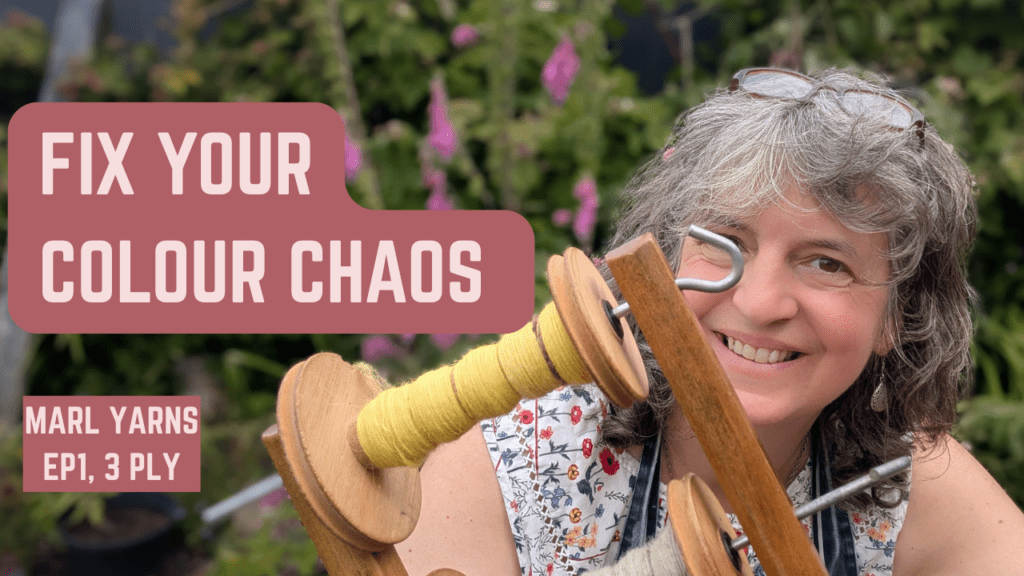Easy Marl Yarns: Hand Spinning with Odds and Ends
One of the great joys of hand spinning is working with colour, those vibrant, juicy braids of combed top that whisper sweet promises of beautiful yarn. But if you’ve ever spun up what you thought would be a stunner and ended up with something more… “muddy puddle” than masterpiece, then welcome. You’re in the right place. Mastering the way to use colour in your hand-spun will elevate your yarn from unusable to stunningly beautiful.
In today’s post, I’m talking all about marl yarn what they are, why you might want to spin them, and how to pick colours that won’t make your skein look like a horrid muddy mess.. I’ll show you how to use a colour wheel to plan a gorgeous three-ply sock yarn from odds and ends from my fibre stash.
This blog post is the accompanying article to the first video in a mini-series about Marl yarns available for free on YouTube.

This post contains affiliate links. If you click on one and make a purchase, I may earn a small commission at no extra cost to you. I only recommend products and resources I genuinely use and love. Your support helps me keep creating helpful content for the spinning and fibre arts community. Thank you!
What Is a Marl Yarn Anyway?
Here’s a confession: I’ve been spinning marl yarns for nearly 20 years without realising there was a name for them. It wasn’t until I was reading Spin-Off magazine’s spring 2025 issue (all about colour, highly recommended!) that I found out there’s a whole word for what I’d been doing.
Marl yarns are simply yarns made by plying two or more singles of different colours. That’s it. You may know them as barber pole yarns, they have that distinctive twist where each strand of colour spirals around the others.
Commercial versions are everywhere, but handspun marl yarns have something extra: that unique, painterly unpredictability that makes them special.
Why Spin a Marl Yarn?
So why might you want to marl? Let me count the ways:
- Use up scraps: Those lovely leftover bits from dye pots and braids? Perfect for marling.
- Avoid muddy colours: By plying distinct singles, you preserve their identity. No more mystery brown.
- Create optical blending: The yarn blends colours subtly without them mixing, it’s like magic!
- Texture & depth: Marls can create yarns with movement, depth, and interest that solid or semi-solids just don’t have.
- Great for socks!: A marl three-ply has the strength, bounce, and colour variation that makes for cheerful, hard-wearing socks.
Picking Colours with a Colour Wheel (And a Bit of Gut Feeling)
Planning a marl yarn, especially a three-ply, can feel a bit like matchmaking. You want drama, but not divorce. This is where the humble colour wheel comes in.
Let’s walk through a little process:

Step 1: Choose Your Dominant Colour
Pick a strong, vibrant shade. For my latest marl, I used a bright yellow I dyed with weld.
Step 2: Find a Tint or Tone
Choose a version of that colour that’s lighter or more muted. This helps you stay in the same family without going full rainbow.
Step 3: Add a Contrast or Shade
Go for something with a bit more depth—a greyed version or something on the edge of your chosen palette. I used a slightly greenish chartreuse, which added a touch of surprise without going too wild.
When in doubt, use colours in the same tonal range, even if they’re technically different hues, they’ll blend beautifully.
Frequently Asked Questions About Spinning Varied Colour Yarns
Here are some questions people actually search for (thank you, internet!)—plus my answers:
❓ What’s the difference between marl and heathered yarns?
Great question! Marl yarns are plied from distinctly coloured singles—you can see the strands. Heathered yarns usually come from fibres that are blended before spinning, giving a more uniform look.
❓ How do I stop my handspun yarn from turning out brown?
Brown (unless intentional!) often comes from over-mixing complementary colours. Marling avoids this by keeping colours separate in the ply. Use a colour wheel to keep your choices harmonious.
❓ Can I marl with naturally dyed fibre?
Absolutely! It’s a brilliant way to use up smaller amounts of naturally dyed fibre that might not stretch to a full skein. Just be sure to test for light- and wash-fastness if your project will be worn or washed often.
❓ What’s the best fibre for marled sock yarn?
I love spinning Welsh Mule for socks, it’s sturdy, takes dye beautifully, and has just the right bounce plus a bit of lustre. But any durable blend with good twist and elasticity will work.
Ready to Try It?
Marling is a joyful, low-pressure way to experiment with colour and fibre. It’s particularly wonderful for sock yarns but the technique works for anything from shawls to sweaters. You don’t need a full braid; just some well-matched leftovers and a bit of curiosity.
I’ll be sharing follow-up videos on using complementary and split-complementary colours in marl yarns, so keep an eye on the channel if you’d like to dive deeper into colour theory for spinners.
Join the Newsletter for More Spinning Fun
If this post has got your fingers itching to dig through your fibre stash, then I’d love to invite you to join my weekly newsletter. I share:
- Behind-the-scenes from my West Wales “studio” (OK, it’s actually my conservatory)
- Natural dyeing tips
- Spinning projects
- Links to new videos
- Plus a lovely free PDF: A Beginner’s Guide to Mordanting Wool with Alum, perfect if you’re curious about natural dyeing.

